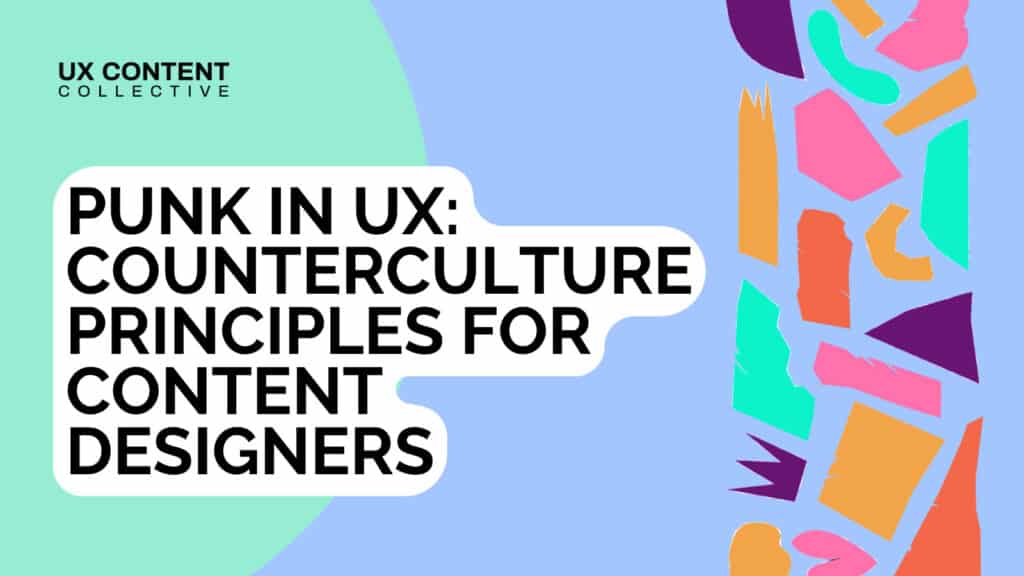

To quote Damian Abraham’s podcast Turned Out a Punk, when most people think of “punk” they think of “a novelty genre that supposedly died out in 1978.” They think of young, white, straight, cis-gendered boys with green mohawks and safety pins through their noses.
But for me, punk has always been much more than that. It’s a genre-defying influence that has connected me to people of all ages, abilities, colors, genders, perspectives, countries of origin, and sexual orientations. It changed the way I perceive and engage with the world. It gave me purpose and principles.
And, as I found out through a recent post on LinkedIn, punk has had the same impact on hundreds of user experience designers I know.
These are some of the principles that punk rock taught us, how they’ve informed our careers in UX design, and how you can apply them in your work.
Music has always been a huge part of my life. I wrote my first song at two, learned bass at six, and joined my first orchestra in elementary school.
When I started a punk band at 13, a wonderful thing happened: My dad didn’t break my records or kick me out of the house. Instead, he gave me a copy of Sandinista! by The Clash. It wasn’t full of three-chord songs played in 90 seconds. It was a three-hour collection of punk, reggae, disco, funk, gospel, and pop that blew my mind.
That record taught me how to think outside the genre and create outside of a silo.
As Aaron Burgess, head of content design at Expedia, said, “I subscribe to the Ian MacKaye definition of punk not as a musical style but as a free space where new ideas can germinate and thrive free of commandments and commandants.”
How does this apply to content design?
Content design isn’t just about the words. It’s designing how information is communicated. And that requires us to understand all of the elements that influence how people receive and perceive information.
Design needs what Bruce Mau calls “whole-brain thinking,” the combination of artistic divergence and scientific convergence. Which means our work can incorporate everything from neuroscience to color theory, game design to narratology. It’s one of the reasons I enjoy design so deeply, because it’s fueled by boundless curiosity.
Pin these principles
Without a purpose, I’m lost. I’m not sure if that’s an ADHD thing, a bipolar thing, or just a human thing. But it’s exceptionally difficult for me to do work just for the sake of doing it. It’s part of why I didn’t stay in college—too many people telling me that I should go instead of explaining why I would benefit.
Punk encouraged my questioning. Through the music and the people, I learned to cultivate that attitude and not to be afraid of asking clarifying questions.
As Margo Stern, content design lead at Peloton Interactive, shared, “Punk certainly informed how I comport myself: a little too fearless, aggressive in the service of doing the right thing, work hard and fast, keep asking why until you get a satisfying answer.”
How does this apply to content design?
“Requirements” for content designers can reach us as prescriptive solutions.
“Can you help with the copy? We need final designs before the end of the day.”
Let’s be honest: this feels limiting, defeating, and exhausting. But (for better or worse), a large part of the job is in how we respond to these moments.
The best tool in our toolset? Asking “why?” Not maliciously or aggressively, but honestly. Because the answer to that question will help us prioritize.
If the user or business benefit is easily explained, we can move it to the top of our priority list and advocate for the time to get it right. “Like you said, this is really important. We better give it the attention it deserves.”
And if the work is low-visibility and low-impact: well, we can’t be a part of everything.
Pin these principles
In Chicago in the late ‘90s and early 2000s, a scourge fell on the scene: gangs of streetpunks.
At best, they policed shows and parties and verbally assaulted people for not being “punk enough.” At worst, they engaged in extreme violence against anyone they didn’t like for any reason.
These gangs primarily consisted of straight, white, cis-gendered men. And they were loathed and vilified by everyone I knew. Friends of all colors, sexualities, genders, abilities, and socioeconomic backgrounds united against bigotry at shows.
And through these events, I learned an important lesson: to beware the gatekeepers.
How does this apply to content design?
As Sarah Mondestin, UX writer at BrainPOP, shares, “I was accepted by some and threatened by others. Often the only Black girl in the group, punk rock absolutely prepared me to be a better UX professional. Now, I’m always thinking of the person who ‘doesn’t belong’ and what they might need to feel more confident.”
It’s imperative that we, as content designers, don’t fall into the metaphor of “edge cases.” Because when we do, we become the gatekeepers. We allow unacknowledged biases to impact not just our work but real people who use our products. We have to consider “stress cases” instead and avoid situations where we could be minoritizing those who are already oppressed.
We have to open the gates for good.
Pin these principles
4. Do it yourself
Somewhere buried in my parents’ basement is a Fisher-Price cassette recorder on which I documented the first song I ever wrote. It was called “I Can Do It By Myself.”For me, a big part of punk was self-reliance and learning by doing. As someone who is neurodivergent, I tend to think curvilinearly and jump into the middle of projects.
As Dexter Zavala, conversational designer at Deloitte, notes, “I’d say playing DIY music and touring…booking national or overseas tours with nothing but a list of random people in cities, deciding to just record a record, designing merch, and hucking enough shirts to go from city to city…there’s a lot of all of that which defines who I am today.”
How does this apply to content design?
We won’t build the perfect experience or find the right words the first time around. Or the second. Or the third. Which is where methods like rapid prototyping (build, review, refine and iterate) help us learn what really works for users.
This also means being proactive about solutions. Running a DIY user test, building style guidelines when there aren’t any, creating our own opportunity. There’s always work to be done, after all.
The caveat (and I’ve learned this the hard way) is not to burn ourselves out trying to do it all on our own. The greatest thing we can do for ourselves and our teams is to ask for their help and their input before the weight becomes too much to carry.
Pin these principles
“Whatever happens tonight, show each other love and compassion.”
Singer Joe Talbot of IDLES screamed those words to a full-capacity audience at Le Bataclan in Paris. The next 90 minutes find the band feeding the audience their positive energy and the audience giving it back in an endless loop.
To me, the ultimate potential of punk is its ability to lift others up, to make misfits like me feel considered and included, and to make joy an act of resistance. And that’s an energy that all UXers can benefit from.
As Ariel von Spronsen, senior content designer at HubSpot, puts it, “I think my years in the punk, grunge, industrial, and later techno scenes have given me a particular ability to see people right where they are, and craft information for that place.”
How does this apply to content design?
When we design, we need to think about the entire experience, which incorporates our users and our coworkers.
Content designers like Candi Williams and Jane Ruffino have wisely observed that to be a content designer is to be a care worker in a digital space. And that requires us to become fearless advocates for all people.
Accessibility and inclusion guidelines not only need to be documented, but they also have to be incorporated into every interaction with our co-creators and users.
Pin these principles
In my late teens, I started conflating punk with self-destruction. When I entered recovery ten years later, I gained a newfound appreciation for the punk philosophers who lived by well-articulated principles.
Those philosophers included people like Ian MacKaye of Fugazi, who had chosen a vegan, drug-free lifestyle. Or Steve Albini, who decided never to take royalties for his music production work, even though he could have made millions doing so.
Dedication to clear decision-making is a trait that unites many in UX. As Erin Williams, head of content design at Walmart, puts it, “I was always a sucker for an ethos.”
How does this apply to content design?
A huge theme emerged for me after hundreds of conversations with design leaders and those new to the field: clearly articulating decisions is at least half of the job, and it’s the skill that hiring managers look for most.
Unlike in marketing, our goal isn’t to present a dozen options for review by stakeholders. Our job as content designers is to explore many directions and present a recommendation to our partners.
Why did we choose one verb over its five synonyms? How does this line of copy solve a user problem? What business objective will this CTA help us achieve?
Preparing for a presentation helps you test your logic and helps your partners deliver more insightful feedback and perspectives. And that makes the product more empathetic and differentiated for users.
Pin these principles
I never imagined I would be here. I never imagined finding a career I love beyond music. I never imagined getting married or owning a home. I definitely didn’t imagine that I would work in tech for a Fortune 1 corporation.
And for those reasons, and many others, it would be disingenuous to label or brand myself as a punk-rock content designer.
But maybe that’s the most important thing punk taught me: to value novelty over nostalgia.
As Joe Strummer once said, “Everyone has got to realize you can’t hold onto the past if you want any future. Each second should lead to the next one.”
I am so very lucky to be here. I can’t wait to see where each second leads me. And where it takes you.
The future is unwritten.
Bill Kurland is a lead content designer for Walmart. He’s been working in content for over 10 years, and he provides free mentorship as much as time allows. He doesn’t make as much noise as he used to, except when he tries to climb out of bed.
Get our weekly Dash newsletter packed with links, regular updates with resources, discounts, and more.
